Feature Article - Changes to labour force survey seasonal adjustment processes
INTRODUCTION
The monthly Labour Force Survey (LFS) is one of the most important ABS labour collections, providing timely information on labour market activity within Australia. The statistics of most interest each month are estimates of the number of employed and unemployed, the unemployment rate and the labour force participation rate.
In December 2003, the ABS published Information Paper: Forthcoming Changes to Labour Force Statistics (cat. no. 6292.0). This paper described a number of changes being made to labour force statistics in late 2003 and early 2004, including two changes to seasonal adjustment processes:
- implementation of concurrent seasonal adjustment; and
- introduction of an adjustment for survey proximity to holiday periods.
This article describes the changes to LFS seasonal adjustment processes.
These changes will result in better quality seasonally adjusted and trend estimates. The changes will not impact on original estimates, but will cause revisions to previously published seasonally adjusted and trend estimates.
The first LFS estimates incorporating these changes to seasonal adjustment processes will be those published in the December 2003 issue of Labour Force, Australia (cat. no. 6202.0), to be released on 15 January 2004.
SEASONAL ADJUSTMENT PROCESSES
Seasonal adjustment is a means of removing the estimated effects of normal seasonal variation from a time series so that the effects of other influences on the series can be recognised more clearly. Seasonal adjustment does not remove the irregular or non-seasonal influences which may be present in any particular month. For a fuller explanation of seasonal adjustment see the article Using the Unemployment Rate Series to Illustrate the Seasonal Adjustment Process published in both the April 2000 issue of Labour Force, Australia (cat. no. 6203.0), and the May 2000 issue of Australian Economic Indicators (cat. no. 1350.0).
Forward Factor Method
In the LFS, seasonal factors are currently estimated using the forward factor method, which reviews the factors annually to take account of each additional year's original data and to examine series for trend breaks, seasonal breaks and outliers. At each annual review, seasonally adjusted estimates for previous periods are revised, and the new forward adjustment factors are projected and then used for the following 12 months.
Concurrent Seasonal Adjustment
Concurrent seasonal adjustment uses original data up to and including the current time period to estimate seasonal factors, and then produce seasonally adjusted and trend series. Concurrent seasonal adjustment is technically superior to the forward factor method of reanalysing seasonal patterns once each year because it uses all available data to fine tune the estimates of the seasonal component each month. With concurrent adjustment, monthly seasonally adjusted series are subject to revisions each month as the estimates of the seasonal factors are improved. It eliminates the need to use projected seasonal factors, and results in improvements in accuracy and consistency of the seasonally adjusted series. In most instances, the only noticeable revisions will be to the estimates for the previous month and for the same month in the preceding year.
In concurrent seasonal adjustment, an annual reanalysis is still conducted, but is limited to examining the series for trend breaks, seasonal breaks and outliers.
Comparing concurrent adjustment with forward factor adjustment
The ABS considers that concurrent adjustment is preferable to forward factor adjustment. Analysis of ABS labour force data has shown that concurrent adjustment generally produces a more accurate initial seasonally adjusted estimate, has less revision over time, and converges more quickly to the final estimate. The use of concurrent seasonal adjustment would have reduced the volatility in some LFS statistics in recent years.
Graphs 1 to 3 show simulated revision histories for a selection of seasonally adjusted series using both the concurrent and forward factor methods. Each graph shows how the estimate for a particular month would have changed over time, from when it was first published to 48 months later. The straight grey line is the 'historical benchmark', which is essentially a stable final estimate (only available at least five years after initial estimation) against which the performance of the two methods can be compared. The thick line is the concurrent estimate and the thin line is the forward factor estimate.
Graphs 1 and 2 are examples of the typical situation where the initial concurrent estimate is closer to the benchmark than the initial forward factor estimate, moving in a series of small revisions that converge on the benchmark earlier than the forward factor estimate. Graph 3 provides an example where concurrent adjustment doesn't provide a better estimate consistently over time, but still shows that the concurrent method converges on the benchmark earlier than the forward factor method. While concurrent estimates will generally be closer to the benchmark than the forward factor estimate, this does not mean that all concurrent estimates will be closer to the benchmarks. It means only that they are closer to the benchmarks on average.
Graph 1, Females employed part-time - revision history for January 1995
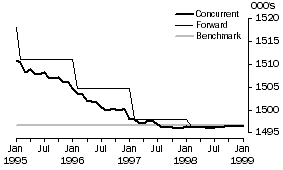 Graph 2, Adult* females employed full-time - revision history for January 1995
Graph 2, Adult* females employed full-time - revision history for January 1995
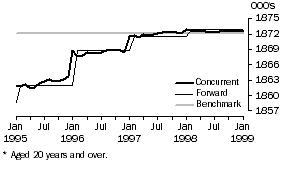 Graph 3, Adult* males employed full-time - revision history for February 1995
Graph 3, Adult* males employed full-time - revision history for February 1995
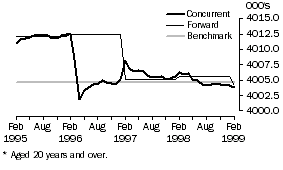
While the examples above demonstrate how the seasonally adjusted estimate for a particular month is revised over time, they do not give a good indication of how the two estimation methods compare over the length of the series. Graphs 4 and 5 display initial seasonally adjusted estimates and the benchmark series for the most recent years that a reliable benchmark can be estimated. This type of analysis is particularly useful for seeing how the two methods would compare for months with large movements when initially released. The thick line is the benchmark series, the circles are the initial concurrent estimates of the seasonally adjusted series, and the solid dots are the initial forward factor estimates of the adjusted series. Graphs 4 and 5 show that, most of the time, the initial concurrent seasonally adjusted estimate is closer to the benchmark series than the initial forward factor estimate.
Graph 4, Seasonally adjusted estimates - adult* females employed full-time
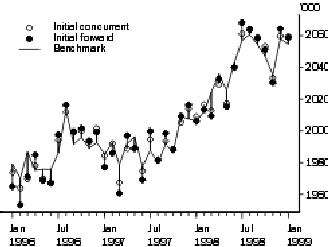 * Aged 20 years and over.
* Aged 20 years and over.
Graph 5, Seasonally adjusted estimates - females employed part-time
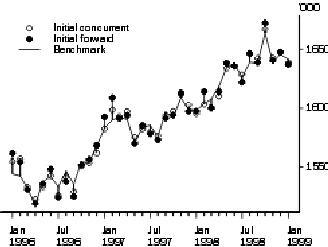
A recent illustration of the improvements that can flow from using concurrent adjustment occurred with the release of labour force figures for January 2003. For employed persons, the initial seasonally adjusted monthly movement (based on forward factors) was +111,000. Had concurrent adjustment been in use at the time, the initial movement estimate would have been +94,000. Although a benchmark estimate for January 2003 will not be available for several years, it is clear from comparisons with recent trend data that the concurrent adjusted movement of +94,000 is likely to be closer to the benchmark than the figure of +111,000 that was released at the time.
Whereas graphs 1, 2 and 3 show the seasonally adjusted estimates for a particular point in time at various 'lags', graphs 6 and 7 show the average (over the period of study) of the absolute percentage revisions of lagged seasonally adjusted estimates for both the concurrent and forward factor methods. The average of the absolute percent revisions of lagged estimates is a global measure of the revision size and convergence speed of the seasonally adjusted estimates. It is calculated using all estimates at a specific lag. That is, the lag zero (0) average revision uses all initial estimates over the period under study; the lag 1 average revision uses the second estimate available for all months of the period under study; and so on. For example, the lag zero January 1995 estimate is the initial estimate using data up to January 1995; the lag 1 estimate is the second estimate of January 1995 using data up to February 1995.
Graphs 6 and 7 show that, on average, the concurrent seasonally adjusted estimates have less revision at each lag than the forward factor estimates, and converge to the benchmark more quickly. These patterns are typical of all the national component series of employment and unemployment.
Graph 6, Females employed part-time - seasonally adjusted revisions
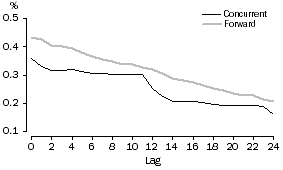 Graph 7, Adult* females employed full-time - seasonally adjusted revisions
Graph 7, Adult* females employed full-time - seasonally adjusted revisions
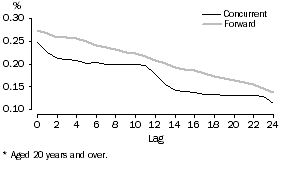
Implications of introducing concurrent seasonal adjustment
In the LFS, original data (i.e. data that is not seasonally adjusted) is generally only revised at the five yearly re-benchmarking to population estimates based on the latest census, and occasionally following definitional changes. As a result, revisions to seasonally adjusted data in the past generally occurred only once a year when the annual reanalysis of seasonal factors was conducted.
Under concurrent seasonal adjustment, all seasonal factors will be subject to revision every month - consequently, all seasonally adjusted and trend estimates may also be revised every month. However, significant revisions will generally only occur for the previous one or two months, as well as one year prior to the current month.
The monthly revisions will require users of LFS seasonally adjusted and trend series to access more data each month in order to ensure that they possess the latest data for all time periods. Previously, for all releases other than February, users needed only access the latest month's seasonally adjusted estimates, and the last seven months' trend estimates (February was the month when revisions to seasonally adjusted labour force series resulting from the annual seasonal reanalysis were released). The move to monthly revisions (under concurrent seasonal adjustment) should not adversely affect the use of seasonally adjusted data, as users generally access an entire time series at once rather than adding the current month's data only. Recent changes to LFS products have facilitated this use of complete time series.
Survey proximity to holiday periods
Both forward factor and concurrent seasonal adjustment methods are able to remove the effect of events which occur at the same time in the survey each year. However, there are some events, like holidays, which are not always at the same time in the survey cycle or which are not at the same time across Australia.
The effects of these types of events on LFS estimates cannot in all cases be removed, because the pattern of their effects cannot be determined. However, two events which have been identified, and can be adjusted for in estimates, are the January interview start date and the timing of Easter.
Interviews for the LFS generally start on the Monday which falls between the 6th and the 12th of each month, except in January, where interviews start on the Monday which falls between the 8th and the 14th, to deal with operational difficulties involved with collecting and processing the LFS around the Christmas and New Year holiday period. If interviews start at the beginning of this bracket, as they did in 2001, then the survey reference period (i.e. the calendar week prior to interview) would include New Year's Day. Alternatively, if interviews start at the end of this bracket, as they did in 2002, then the reference period will start on 7 January.
The timing of Easter varies from late March to late April. As a result, Easter may fall between the March and April interview periods, during the April interview period, or after the April interview period.
Analysis has shown that the proximity of LFS interviewing to holidays can have an effect on both people's availability for the interview and on their labour market involvement.
A specific adjustment for this effect in respect of the January interview start date and the timing of Easter will be introduced to coincide with the introduction of concurrent seasonal adjustment. For more information on the effect of the survey proximity to holiday periods on labour force estimates, please refer to the feature article Volatility of Labour Force Estimates in the December 2002 issue of Labour Force, Australia (cat. no. 6203.0).
Introduction of seasonal adjustment process changes
The first estimates to incorporate concurrent adjustment and the holiday effect changes to the seasonal adjustment process will be those published in the December 2003 issue of Labour Force, Australia (cat. no. 6202.0), to be released on 15 January 2004. The introduction of these two changes will mean that some estimates in seasonally adjusted and trend series may be revised as far back as February 1978.
FURTHER INFORMATION
Information Paper: Forthcoming Changes to Labour Force Statistics (cat. no. 6292.0), released on 16 December 2003, provides further details of changes being introduced to the LFS.
For further information about the technical details of concurrent seasonal adjustment, contact Craig McLaren on Canberra 02 6252 6540, or via email craig.mclaren@abs.gov.au.
 Print Page
Print Page
 Print All
Print All